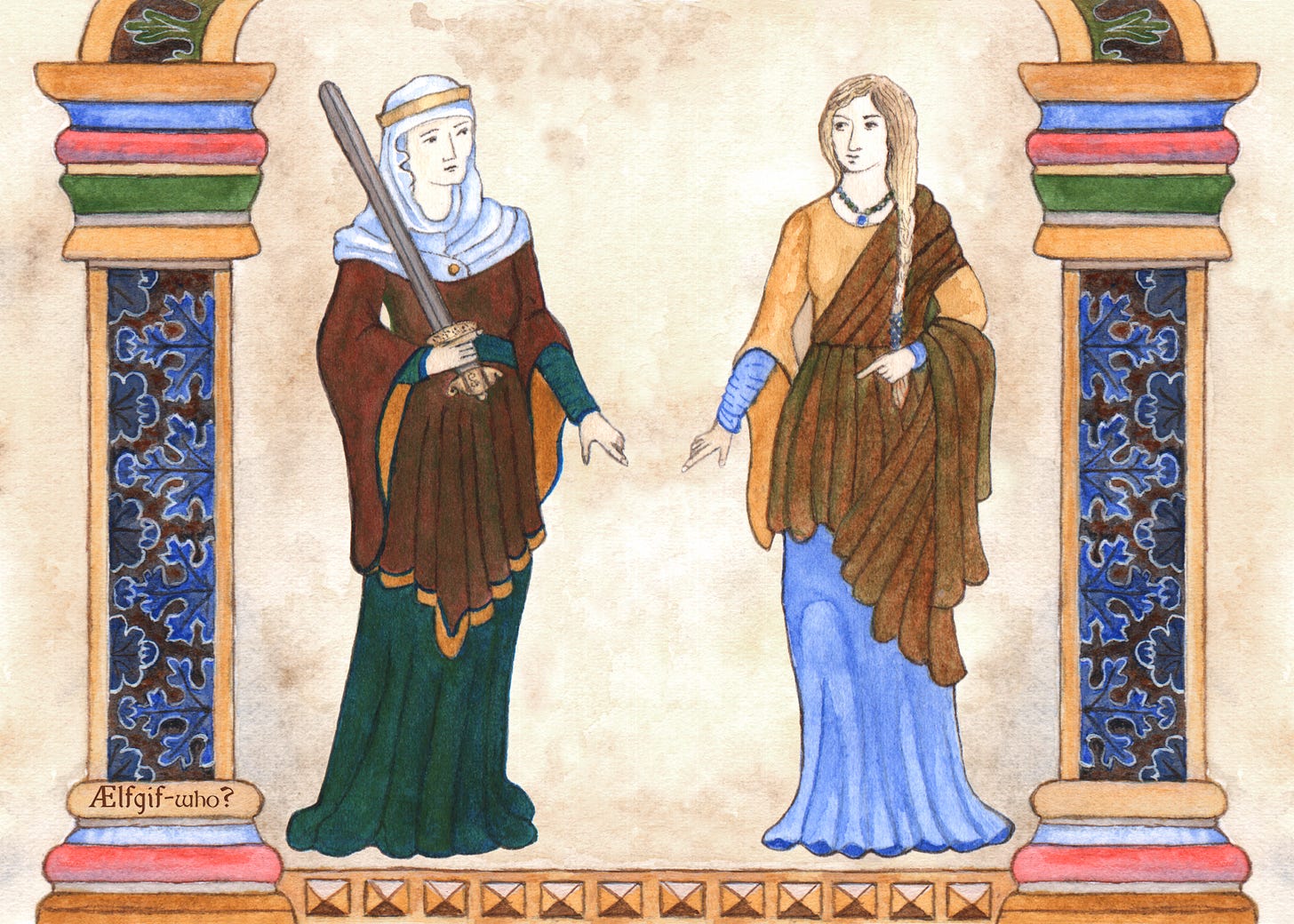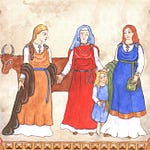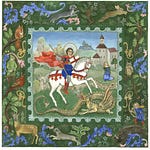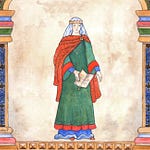Ælfgif-who? provides short biographies of early medieval English women every two weeks. Click on the podcast player if you’d like to hear this newsletter read aloud in my appealing Yorkshire accent.

Æthelflaed and Ælfwyn: The Women who Ruled Mercia in the Viking Age
Æthelflaed was born in the 870s, at the height of Viking invasions in England. She was the eldest child of King Alfred of Wessex and his wife Ealhswith. Though born into the West-Saxon royal house, her maternal grandmother Eadburh was of Mercian royalty. Æthelflaed was raised in a court that did not support powerful women. Asser, who wrote the Life of Alfred, tells us that:
The West Saxons did not allow the queen to sit beside the king, nor indeed did they allow her to be called ‘queen’, but rather ‘king’s wife’.1
However, by 887 Æthelflaed was no longer at the West-Saxon court, having married the ruler of Mercia, Æthelred. This marriage cemented a political alliance between Alfred and Æthelred, helping them to work together against Scandinavian conquest. Mercia had a history of powerful queens like Cynethryth (fl. 770-798), queen of Offa. However, much had changed in the century between the period of Mercian power over the other kingdoms during Offa’s reign and the time of the marriage of Æthelflaed to Æthelred. Mercia’s power and area of influence had declined due to political instability and ravaging attacks from Scandinavian invaders. The southern kingdom of Wessex had been relatively protected from these attacks compared to the northern kingdoms of Mercia and Northumbria, and as such Wessex had become the more powerful kingdom. Historians generally agree that in this period Æthelred of Mercia was not a king, but a ruler under the overlordship of King Alfred. Understanding this relationship is complicated by the fact that most of our source material for this period is West-Saxon in origin.
At some point during the 890s Æthelred started to suffer from ill health, and Æthelflaed began ruling on his behalf. When he eventually died in 911, she appears to have taken over ruling in her own right: something no other woman hitherto had done in early medieval England. A collection of annals describing the years 902-924, with a concentration on 909-919, referred to as the ‘Mercian Register’ or sometimes the ‘Annals of Æthelflaed’, have a particular interest in Æthelflaed’s activities, and in royal women in general. They appear to be of Mercian origin, and they survive in three manuscripts containing what are known as the ‘Anglo-Saxon Chronicles’. References to women are rare in the Anglo-Saxon Chronicles, but frequent within this small collection of Mercian annals.
These annals describe Æthelflaed as ‘Myrcna hlaefdige’ (Lady of the Mercians), the equivalent of her husband’s title of ‘Myrcna hlaford’ (Lord of the Mercians). The annals tell us how Æthelflaed built defensive fortifications in ‘Bremesbyrig’ in 910 while her husband was still alive, then after his death she built fortifications in ‘Scergeat’ and Bridgnorth in 912, Tamworth and Stafford in 913, Eddisbury and Warwick in 914, Chirbury, ‘Weardbyrig’ and Runcorn in 915, and recaptured the burhs of Derby and Leicester from the Scandinavians in 917 and 918. It also recounts how she sent an army into Wales and destroyed Brecon, capturing the king’s wife and thirty-three other hostages, and in the year of her death in 918 she also convinced the people of York to give pledges and oaths that they would support her leadership. Apart from a few astronomical events and a notice of the translation of Saint Oswald’s body into Mercia (a move instituted by Æthelflaed), the overwhelming contents of these annals is concentrated on Æthelflaed’s military, defensive and strategic deeds in order to protect Mercia and undermine Scandinavian rule. A later medieval Irish account corroborates this, also stating that she led an army against the Viking Ragnall at the second battle of Corbridge in 918 and that she made an alliance with the Picts and the Scots against Viking aggressors in Northumbria.
Æthelflaed’s deeds are recorded in the Mercian Register as any male ruler’s would be. By all accounts she was a strong ruler with a strong military influence. There is no evident demarcation of her gender apart from in the use of her title, ‘hlaefdige’. Her brother Edward the Elder, King of Wessex (r. 899-924) is hardly mentioned, and her husband is mentioned only twice. Though these annals prioritise Æthelflaed’s deeds and ignore Edward’s, a collection of West-Saxon annals for the same year does the exact reverse, prioritising Edward’s deeds and mentioning Æthelflaed only once as ‘Edward’s sister’. These two texts, recording the same period of history but from very different viewpoints, perhaps reveal an ongoing struggle between Mercia and Wessex during Æthelflaed’s reign. Edward of Wessex appears to have tried to gain some West-Saxon control over Mercia. After Æthelred died, Edward took control of London and Oxford, towns previously under Mercian power. He had also sent his son Æthelstan to be brought up by Æthelflaed and Æthelred at the Mercian court, perhaps envisaging a future unification of the two kingdoms.
After Æthelflaed died, her daughter Ælfwyn succeeded as ruler of Mercia. Ælfwyn was almost thirty but still unmarried, an unusual situation for a woman of this period to be in (apart from in the case of nuns), which suggests her succession as ruler may have been planned long in advance. This is the only woman-to-woman succession of rulership recorded in English history, until Queen Elizabeth I succeeded after her sister Mary in 1558. The extent to which either Æthelflaed or Ælfwyn can claim queenship is complex, but worth considering. While West-Saxon sources referred to Æthelflaed as ‘hlaefdige’ (lady), Welsh and Irish sources regarded her as a queen. The charters she signed and co-signed, and the Mercian register, describe her rulership as being undertaken ‘with the help of God’ or ‘by the grace of God’, strong terms that bring her into the context of a growing ideology of Christian (royal) rulership.
However, the political reality did not support Ælfwyn’s position. After ruling Mercia for only six months, she was deposed by her uncle King Edward. The Mercian Register states that she was ‘deprived of all authority in Mercia and was led into Wessex three weeks before Christmas’. It is not known what became of her. Ælfwyn’s deposition was instrumental in the eventual creation of a unified England that happened under her cousin Æthelstan, who had been raised perhaps with Ælfwyn by Æthelflaed at the Mercian court. It is worth questioning why a sub-ruler such as Ælfwyn, if that is indeed all she was, would need to be deposed and physically removed from Mercia in order for Edward to take control.
Æthelflaed’s position as a woman whose identity was as Mercian as it was West-Saxon certainly complicates how we should view these developments. If she had stayed in Wessex where royal women had low status, her life would certainly have played out very differently. But as the daughter of the most powerful king in England, Æthelflaed’s marriage to Æthelred may have been designed to cement an overlordship of Wessex over Mercia. Perhaps this, along with her strong, military rulership, is why her rule in the kingdom was tolerated by Edward – she was a West-Saxon ruler. After her death, Edward could not afford an independent Mercian ruler, instead preferring to create in his own son and heir a dual identity comparable to Æthelflaed’s.
Æthelflaed and Ælfwyn, as women who ruled in their own right, are certainly anomalous in the history of medieval England, but Æthelflaed’s identity, as a woman between two kingdoms on the verge of unification, arguably placed her in the perfect position to rule.
Suggestions for further reading:
Asser’s Life of Alfred, ed. By Simon Keynes and Michael Lapidge (affiliate link)
I would recommend Mercia: An Anglo-Saxon Kingdom in Europe (2005) edited by Michelle Brown and Carol Farr. It’s an academic book, so may be expensive to buy, but you could try requesting it from your local library or seeing if your nearest university library has a copy. Alternatively, a lot of it is available on the Google Books preview. It contains, among other interesting chapters, an essential article about ‘Political Women in Mercia’ written by Pauline Stafford.
Simon Keynes and Michael Lapidge eds., Alfred the Great: Asser's Life and Other Contemporary Sources (London: Penguin 1983).














Share this post